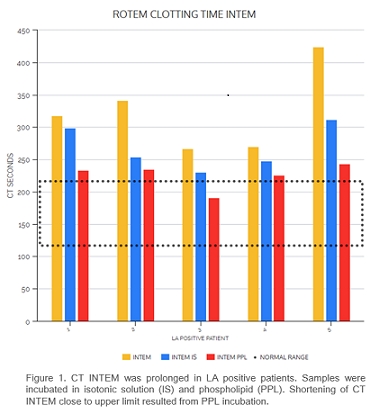Session Information
Session Type: ACR Poster Session B
Session Time: 9:00AM-11:00AM
Background/Purpose: Interpretation of coagulation tests remain a challenge in jSLE with positive aPL. Lupus anticoagulant (LA) can mimic bleeding diathesis and its effect on prolonged aPTT is well documented. Rotational thromboelastometry (ROTEM) is a recently approved tool that assesses primary and secondary hemostasis. It has gained utility in the surgical setting and helps guide therapeutic transfusion decisions. The utility of ROTEM for patients with jSLE who have a positive LA has not been defined. We hypothesized that LA affects ROTEM parameters, especially clotting time (CT) and maximum clot firmness (MCF).
Methods: A prospective observational study was conducted from 12/1/15 to 05/30/16 in a pediatric rheumatology clinic after IRB approval was obtained. jSLE patients with current or previous LA positivity were included. Positive LA was defined by positivity of either a hexagonal phase neutralization procedure or dilute Russell’s viper venom test. ROTEM was performed using 3 different assays reflective of coagulation pathways; INTEM (intrinsic), EXTEM (extrinsic) and FIBTEM (platelet-inhibited extrinsic pathway). When clotting time (CT) of INTEM was prolonged, the sample was incubated with phospholipids and CT measured again. Correlation between ROTEM results with standard coagulation tests were done by using Pearson’s correlation coefficient. Clinical data was presented in mean ± standard deviation. We compared CT parameters in patients with and without aPL mediated clinical features (MS Excel, 2013).
Results: Twelve jSLE patients were recruited; 83% (10) were female, mean age was 16 ± 2.5 years. Ten were Hispanics, duration of disease was 3.25 ± 3 years, SLEDAI score was 3.8 ± 3. Five (42%) patients had aPL mediated clinical features: RP (1), livedo reticularis (1), thrombocytopenia (1), cutaneous ulceration (1), and pulmonary embolism (1). Two patients were on anticoagulation for history of thrombotic events. Immunomodulatory therapy as indicated by the disease severity included CYC (4), Rituximab (5), MTX (3), AZA (5) and MMF (2). All patients were on HCQ and ASA. Mean prednisone dose was 16.8 ± 15 mg/day. A total of 13 samples were obtained, 6 patients had a positive LA. In all children with strong LA, a positive correlation between aPTT and CT prolongation in both INTEM (r= 0.97; p 0.003) and EXTEM (r=0.988; p 0.001) was seen. Comparison between CT prolongation of ROTEM parameters and aPL mediated clinical features were not statistically significant. Elevation in MCF did not correlate with strong LA. Phospholipid incubation did correct all INTEM CT prolongation abnormalities (Figure 1).
Conclusion: LA affects ROTEM by prolonging clotting times as it does other traditional assays. Pediatric rheumatologists should interpret ROTEM coagulation tests with caution in jSLE patients undergoing surgical intervention or presenting with bleeding.
To cite this abstract in AMA style:
Pereira M, Muscal E, Hensch L, Kostousov V, Bruzdoski K, Hui SK, Teruya J, DeGuzman M. Effect of Lupus Anticoagulant on Rotational Thromboelastometry in Juvenile Systemic Lupus Erythematosus: Preliminary Data on a Single Center Cohort [abstract]. Arthritis Rheumatol. 2016; 68 (suppl 10). https://acrabstracts.org/abstract/effect-of-lupus-anticoagulant-on-rotational-thromboelastometry-in-juvenile-systemic-lupus-erythematosus-preliminary-data-on-a-single-center-cohort/. Accessed .« Back to 2016 ACR/ARHP Annual Meeting
ACR Meeting Abstracts - https://acrabstracts.org/abstract/effect-of-lupus-anticoagulant-on-rotational-thromboelastometry-in-juvenile-systemic-lupus-erythematosus-preliminary-data-on-a-single-center-cohort/

